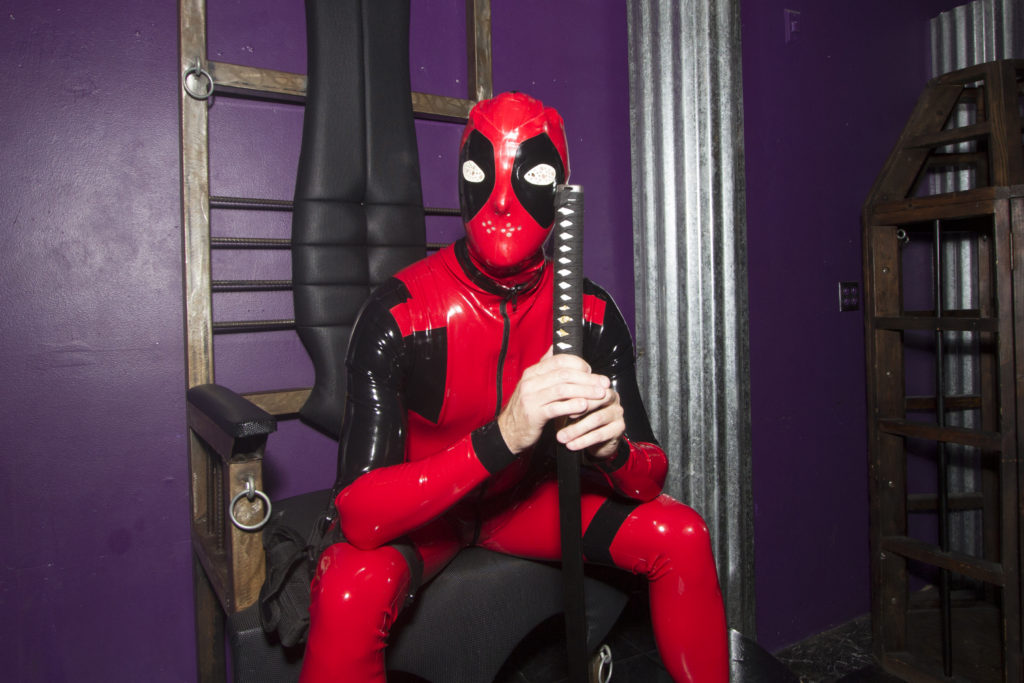
Certain characteristics such as height and hair and eye color are determined by a person’s genetic makeup before birth. It has been argued that personality traits like sarcasm or shyness can be passed from parent to child. For BDSM community member Janice Hartz-Pettit, the apple did not fall far from the tree; genetically speaking or not.
Hartz-Pettit and her mother came out to each other at the same time. It was an opportunity for both women to gain a better understanding of one another. Though she had already visited a number of the websites her mother brought up during their conversation, Pettit was not prepared for one item in particular.
“I got up and went into my mom’s room and I said, ‘So you’re into BDSM?’ So she gets a purple gym bag and plops it down and asks me, ‘Do you want to see my toy bag?’ and pulls out this giant purple dildo. I’m like, ‘No, I don’t want to see your toy bag! No, I changed my mind!’” Pettit says.
Hartz-Pettit joined the alternative community when she was 18. As the collective acronym entails, the subculture consists of Bondage and Discipline, Dominance and Submission, and Sadism and Masochism.
Hartz-Pettit, now 34, is the co-event coordinator for Threshold Society and does community outreach for BDSM.
While Hartz-Pettit could take solace in knowing that her mother accepted her shared interest, some members of the community are not as lucky nor do they feel comfortable enough to let others know.
Those who do choose to come out, are often stigmatized.
Brit-El Mabourakh, program director for Pierce College’s KPCRadio.com, has been in the BDSM scene for five years. The therapist she was seeing outed her to her mother when she was 15. Mabourakh’s mother was not too pleased when she found out about her daughter’s deviant desires.
As reprimand for her involvement in BDSM, Mabourakh lost friends that she had once been close to.
“People think that I’m some kind of self-hating person or [that] you can’t be a feminist and be kinky and [that] all men who have rough sex hate women,” Mabourakh says. “I’m open about it because I don’t want it to be an issue with people. If they are going to have an issue with the fact that I am a 24/7 kinky person, then you don’t want to be friends with me. It’s not something I shove in people’s face, but I think it’s always going to be a part of my life.”
BDSM is an umbrella term that encompanses everything about the community and world. It includes what they do, the types of personal relationships that they create, and the subcultures within it.
“There are two schools of thought in BDSM. The old motto is safe, sane, and consensual. But if you like things that are more hardcore, I’m more of the school of thought of risk-aware consensual kink, which is more serious impact play,” Mabourakh says. “Yeah, you’re going to get a little more banged up, but it’s something that’s communicated and negotiated.”
It is common practice for people who indulge in this pastime to closet their activities. This is either done out of fear for their personal or professional relationships or because they are ashamed of their inclinations.
“One of the things that’s important for them is that separation of a private life and a professional life,” Hartz-Pettit says. “There are people who don’t go out and participate in things in a more public manner. We don’t have to hang out and dress in our fetishy [sic] latex to feel like we are still a part of this community.”
According to therapist and fellow kink enthusiast Jennifer Marsi, people become involved with BDSM that can be seen on websites similar to https://www.hdsexvideo.xxx/, for any number of reasons. Some are working through past trauma, while others are trying to gauge their limits. Then, there are those looking for a rush.
“It’s a deeper exploration of themselves and their partners. I have a lot of friends and family that may not understand it, but they support me and they get that I’m safe,” Marsi says. “For some, it’s merely a fun addition to their otherwise vanilla life. For others, it’s how they live. It’s how they structure their significant relationships.”
For some, this is a leisure activity used to release the cumulative stresses that have been experienced through the day or week. For others, this is their profession and they have learned to balance work and play.
“For some people it may mean going to the occasional party,” Masri says. “To others, like myself, I work in the scene. I play in the scene. I have relationships in the scene [and] my friends are in the scene.”
Masri, who is a marriage and family therapist, has been part of the BDSM community for six years. While her practice is open to all, the majority of her clients are people in the scene.
“When I started my practice, I was already heavily involved in the scene and teaching classes. I specialize in alternative lifestyles, BDSM, poly, kink, and dominant/submissive relationships. It was a natural progression that people would hear about that,” Masri says. “Therapists that specialize in this are hard to come by.”
For similar reasons, Mabourakh intends to pursue a career in psychology with a focus in alternative relationships.
“We are not at a point in society where people can have respect for people’s identities. People can still have pretty bad real world effects,” Mabourakh says. “I’m going to be as open as I can be possibly in a respectable capacity because I think that it’s super neglected by psychologists and therapists.”
It is Mabourakh’s belief that those who are not in the scene—referred to as the mainstream or vanilla—are often unable to understand the relationship dynamics in the community.
“People think that BDSM is an exaggerated version of normal sex. In BDSM, you sit down [and] talk to each other,” Mabourakh says. “Communication and consent is such a huge thing. People have a hard time wrapping their minds around it because in their head you don’t hit the people you love, you don’t cut the people you love.”
There are several roles that members in the community can identify as. The most accessible ways to identify participaters is in one of the three: dominant, submissive or the switch. Other identifiers are the top and the bottom.
Though top and dominant—and bottom and submissive for that matter—are often used interchangeably, there is an important distinction between the two sets.
“In my experience, if someone identifies as purely a top or a bottom and not as a sub, a slave, a dom, a mistress, typically it’s because they are interested in play and not a power exchange,” Masri says. “Those that identify as a bottom know that they like to be on the receiving end of play, but are not comfortable with giving up that power.”
A dominant and submissive relationship is defined by who has psychological control over the other, such as one person controlling and commanding another’s behavior.
Top-bottom relationships are defined by who performs the acts and who receives them. Someone can be bottom during sexual acts and still be the dominant person in the relationship. They can also be a switch and alternate between all of the positions.
“I think a lot of people coming in are focused on the physical aspect to it,” Masri says. “There’s the relationship dynamic and a lot of people don’t think of that because they don’t go past the idea of chains and whips.”
The emphasis on communication and strong relationships has been a bastion in the community. And while recent published works have attempted to shed light on the subculture by bringing it into the mainstream media, few have succeeded.
According to Masri, 50 Shades of Grey, has portrayed the BDSM community inaccurately and is a major cause of misconceptions from outside perspectives.
“I read the entire series, which I did out of obligation because I knew I’d be speaking about it at some point,” Masri says. “I really didn’t like that they portrayed his character as someone who had evolved into a dominant due to abuse and his salvation was becoming more vanilla. A vanilla character came in and she ‘fixed’ him. It falls into a couple [of] huge stereotypes, which was a bit more upsetting to people in the scene.”
One major aspect that the series neglected, Masri says, is the absence of aftercare and the lack of emphasis on communication and negotiation.
“There’s a lot of communication in the scene and there has to be, because we are doing things that are risky, physically and emotionally. I’m seeing studies done for vanilla relationships like, ‘Checking in with your partner on a regular basis can increase happiness by this much’ and I’m here like, we already do that shit,” Masri says. “There’s a lot of stuff we do that is really healthy, relationship and communication-wise, that you now see mainstream society picking up on, and not giving us credit for and repackaging it for the vanilla world.”
The series also perpetuated the myth that people in the scene come from abusive backgrounds.
“Studies have shown that the amount of people who have been abused that are in the scene are approximately the [same] amount as the people in the mainstream,” Masri said. “It’s not an if this, then that relationship. I think a lot of that will start to shift with better understanding.”
Masri adds that another misconception is that physical activities are most important in a BDSM relationship. If roles are acknowledged, they are stereotyped. Dominant types are seen as narcissist control freaks and submissive types are floor mats who don’t have a voice.
“I think that people can get caught up in the sex acts themselves, but the serious action goes on in the dynamics. Communication is vital for any healthy BDSM relationship,” Mabourakh says. “As a community, we have a strict set of values and most of us stick to them pretty well.”
Marsi says that she has become the face for people new to the scene. Apart from her counseling services, Marsi has also organized and hosted various events geared toward new people in the scene. She hosts weekly BDSM 101 classes and hosts a monthly play party, Club Awakening.
“Club Awakening is a play party that’s a safe place to explore various types of play,” Marsi says. “I have volunteers that are just out there to talk to people. We also have practice bottoms if you didn’t come with anyone.”
According to Janice, 10 to 15 years ago it wasn’t as easy for a kinky person to find like-minded individuals to have sessions with.
“A person would figure out that there was a name for this thing they were doing and it didn’t make them a horrible sociopathic serial killer. It used to be that you could only go to events like this if you got an invitation from someone you knew, you had to get a reference, someone who would vouch for you,” Janice says. “That was a huge thing years ago, where everybody was constantly looking for that person who was more knowledgeable to teach them. Now, because BDSM see on websites like https://www.cartoonporno.xxx/ has become more mainstream, there are classes especially in LA. Now there are public dungeons.”
Though meeting and organizing a community in the scene is easier now, according to Mabourakh, there is still a gap not filled younger folk.
“Many people who are in their early twenties, even if they are kinky, they aren’t too open about it because they are still getting to know themselves,” Mabourakh says. “I’ve always been very open, so I got into things and was more confident about it from a young age. I don’t know if a lot of people can say the same, unfortunately.”
According to Janice, there are generational categories within the community. TNG (the next generation) is from 18 to 35. After 35, is the midguard and after that is oldguard.
“People who are TNG are like, ‘I’m going to go out and get five pounds of sprinkles and I’m going to beat you until it explodes.’ The easiest way to describe the difference would be a TNG person might hit someone with a ping pong paddle, whereas an old guard person may take a ping pong paddle and put nuts and bolts and screws on it and hit someone with that,” Janice says. “So there’s the super hardcore level of deviant and there’s the lighter, younger version because they haven’t quite graduated into that level yet.”
Despite that, Janice thinks that newer generations are more accepting to other ways of life.
“I think as generations change, we go away from the idea that things have to be hidden away in the closet. We are learning to be more accepting of ourselves and other people in society,” Janice says. “The more people that are willing to be unashamed and unafraid of the stigma we hold ourselves to, what we like, what we do, what we practice on the private levels. We become more comfortable expressing those things to the rest of the world. Our generation is more brave than the generation before us.”
“Most people in life have secret desires, things they’d love to explore,” Marsi added. “But they repress them, they shut them down if they are not “acceptable”. In the scene we are allowed to do that. We can explore the deep dark corners, not only of sexual desires, but of who we are as people.



